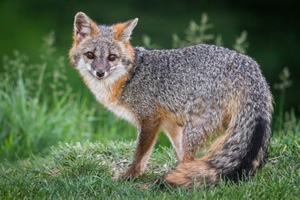Unlike their distant red fox cousins, gray foxes are not moving into urban and suburban areas. They still prefer living in forested and brushy woodland areas.
The scientific name of the gray fox can be translated as “ashen silver” but their fur is not a solid gray. They have salt-and-pepper coloring with some reddish fringes and these distinguishing features:
- Tail with a black tip and black stripe running along the center
- Deep-chested body with strong neck
- Stout, short, powerful legs
- Strong hooked claws
Gray foxes range in size from 30 to 44 inches, with the tail about ⅓ the size of their body (10 to 17 inches).


If you ever spot a gray fox on the roof of a house, you’re not seeing things. Gray foxes are one of only two members of the dog family that can climb trees. (The other is the Asian raccoon dog.) The gray fox can jump from branch to branch of a tree to get around.
Like the red fox, the gray fox isn’t usually aggressive in Baltimore and doesn’t pose much of a threat to humans. These pests can carry rabies and a tapeworm that infects humans, however. Be wary around any gray fox that is acting unnaturally tame, foaming at the mouth and/or staggering around or circling.
Unlike the red fox, the gray fox doesn’t usually go after poultry. It is an omnivore and eats rodents, rabbits, birds, reptiles and amphibians and insects. It also eats more fruit than the red fox.
The gray fox likes to make its den in hollow trees or under a building (or a porch). That’s where the adults raise their pups (3 to 5 is an average litter).

As a Home Protection Plan customer, if you’re not satisfied with our pest control service, we will service your home at no additional cost until your issue is solved or receive your money back from your last scheduled service.

If gray foxes are invading your space and you’d like to keep them away, here are 5 things you can try to discourage them from settling in:
- Make loud noises (banging pots and pans)
- Use motion-activated sprinklers
- Place balloons at the entrance of a den
- Place something unpleasant-smelling—used kitty litter, a sweat-soaked shirt, etc.—in the den opening
- Remove food sources (bird feeders, pet food, fallen fruit)
If the gray foxes remain a problem, contact Brody Brothers Pest Control in Baltimore, MD at 410-653-2121 for help in getting them to leave.


